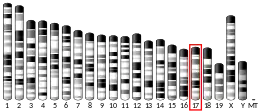C19orf70
Chromosome 19 open reading frame 70, also known as QIL1, MICOS complex subunit MIC13 (MIC13) or Protein P117 is a protein that in humans is encoded by the C19orf70 gene.[5][6]
| MICOS13 | |||||||||||||||||||||||||||||||||||||||||||||||||||
|---|---|---|---|---|---|---|---|---|---|---|---|---|---|---|---|---|---|---|---|---|---|---|---|---|---|---|---|---|---|---|---|---|---|---|---|---|---|---|---|---|---|---|---|---|---|---|---|---|---|---|---|
| Identifiers | |||||||||||||||||||||||||||||||||||||||||||||||||||
| Aliases | MICOS13, P117, QIL1, MIC13, chromosome 19 open reading frame 70, mitochondrial contact site and cristae organizing system subunit 13, C19orf70, MIC12 | ||||||||||||||||||||||||||||||||||||||||||||||||||
| External IDs | OMIM: 616658 MGI: 2442174 HomoloGene: 17699 GeneCards: MICOS13 | ||||||||||||||||||||||||||||||||||||||||||||||||||
| |||||||||||||||||||||||||||||||||||||||||||||||||||
| |||||||||||||||||||||||||||||||||||||||||||||||||||
| |||||||||||||||||||||||||||||||||||||||||||||||||||
| |||||||||||||||||||||||||||||||||||||||||||||||||||
| Wikidata | |||||||||||||||||||||||||||||||||||||||||||||||||||
| |||||||||||||||||||||||||||||||||||||||||||||||||||
Structure
The C19orf70 gene is located on the p arm of chromosome 19 at position 13.3 and it spans 2,482 base pairs.[5] The C19orf70 gene produces a 9.7 kDa protein composed of 88 amino acids.[7][8]
Function
The C19orf70 gene encodes for a subunit of the MICOS (mitochondrial contact site and cristae junction organizing system) complex of the mitochondrial inner membrane. The 700-kD complex plays diverse roles such as the maintenance of crista junctions, formation of contact junctions to the outer membrane, and the dynamic regulation of mitochondrial membrane architecture. C19orf70, a component of the mature MICOS complex, localizes to the inner mitochondrial membrane at the cristae junctions and incorporates MINOS1 and MIC10 into the MICOS complex. The protein is necessary for the creation of the cristae junction, integrity of the cristae junction, and maintenance of cristae morphology. It is also essential for normal mitochondrial function.[9][6]
Clinical Significance
Mutations in C19orf70 has been shown to result in mitochondrial deficiencies and related disorders caused by the disassembly of MICOS complex with abnormal cristae morphology and failure of mitochondrial respiration. Major clinical manifestations have included mitochondrial hepato-encephalopathy and 3-methylglutaconic aciduria accompanied by severe psychomotor retardation, intractable seizures, cerebellar atrophy, early death, Lactic acidemia, neutropenia, and elevated liver transaminases.[10]
Interactions
C19orf70 has been known to interact with MRPL24, APOOL, STOML2, IMMT, MTX1, CHCHD3, and other proteins.[11][6]
References
- GRCh38: Ensembl release 89: ENSG00000174917 - Ensembl, May 2017
- GRCm38: Ensembl release 89: ENSMUSG00000049760 - Ensembl, May 2017
- "Human PubMed Reference:". National Center for Biotechnology Information, U.S. National Library of Medicine.
- "Mouse PubMed Reference:". National Center for Biotechnology Information, U.S. National Library of Medicine.
- "Entrez Gene: Chromosome 19 open reading frame 70".
- "MIC13 - MICOS complex subunit MIC13 - Homo sapiens (Human) - MIC13 gene & protein". UniProt. Retrieved 2018-08-15.
- Zong NC, Li H, Li H, Lam MP, Jimenez RC, Kim CS, Deng N, Kim AK, Choi JH, Zelaya I, Liem D, Meyer D, Odeberg J, Fang C, Lu HJ, Xu T, Weiss J, Duan H, Uhlen M, Yates JR, Apweiler R, Ge J, Hermjakob H, Ping P (Oct 2013). "Integration of cardiac proteome biology and medicine by a specialized knowledgebase". Circulation Research. 113 (9): 1043–53. doi:10.1161/CIRCRESAHA.113.301151. PMC 4076475. PMID 23965338.
- "Protein QIL1". Cardiac Organellar Protein Atlas Knowledgebase (COPaKB). Archived from the original on 2018-08-16. Retrieved 2018-08-15.
- Guarani V, McNeill EM, Paulo JA, Huttlin EL, Fröhlich F, Gygi SP, Van Vactor D, Harper JW (May 2015). "QIL1 is a novel mitochondrial protein required for MICOS complex stability and cristae morphology". eLife. 4. doi:10.7554/eLife.06265. PMC 4439739. PMID 25997101.
- Zeharia, A; Friedman, JR; Tobar, A; Saada, A; Konen, O; Fellig, Y; Shaag, A; Nunnari, J; Elpeleg, O (December 2016). "Mitochondrial hepato-encephalopathy due to deficiency of QIL1/MIC13 (C19orf70), a MICOS complex subunit". European Journal of Human Genetics. 24 (12): 1778–1782. doi:10.1038/ejhg.2016.83. PMC 5117932. PMID 27485409.
- Mick DU, Dennerlein S, Wiese H, Reinhold R, Pacheu-Grau D, Lorenzi I, Sasarman F, Weraarpachai W, Shoubridge EA, Warscheid B, Rehling P (December 2012). "MITRAC links mitochondrial protein translocation to respiratory-chain assembly and translational regulation". Cell. 151 (7): 1528–41. doi:10.1016/j.cell.2012.11.053. PMID 23260140.
Further reading
- Anand R, Strecker V, Urbach J, Wittig I, Reichert AS (2016). "Mic13 Is Essential for Formation of Crista Junctions in Mammalian Cells". PLOS ONE. 11 (8): e0160258. Bibcode:2016PLoSO..1160258A. doi:10.1371/journal.pone.0160258. PMC 4968808. PMID 27479602.
- Zeharia A, Friedman JR, Tobar A, Saada A, Konen O, Fellig Y, Shaag A, Nunnari J, Elpeleg O (December 2016). "Mitochondrial hepato-encephalopathy due to deficiency of QIL1/MIC13 (C19orf70), a MICOS complex subunit". Eur. J. Hum. Genet. 24 (12): 1778–1782. doi:10.1038/ejhg.2016.83. PMC 5117932. PMID 27485409.
This article incorporates text from the United States National Library of Medicine, which is in the public domain.



